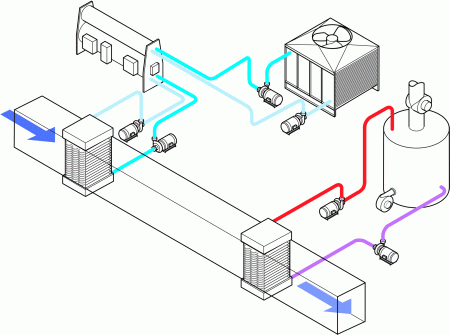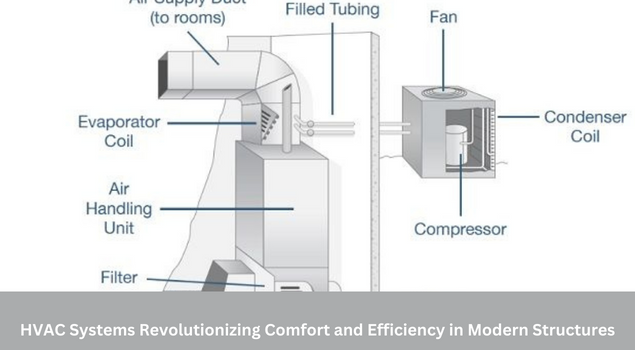HVAC Systems Revolutionizing Comfort and Efficiency in Modern Structures HVAC( Heating, Ventilation, and Air Conditioning) systems play a pivotal part in maintaining optimal inner conditions, icing comfort, and enhancing energy effectiveness in domestic, marketable, and artificial structures. Over time, HVAC technology has evolved significantly, transforming the way we live and work. This composition provides a comprehensive overview of HVAC systems, their factors, working principles, energy effectiveness measures, and recent advancements.
Components of an HVAC System

HVAC systems correspond to several factors that work together to give heating, ventilation, and air exertion. Let’s explore each of these factors in detail
Heating System
The heating element of an HVAC system is responsible for generating and distributing heat to maintain a comfortable inner temperature during cold rainfall. The most common types of hotting systems include
- Furnaces: Furnaces burn energy, similar to natural gas, oil painting, or propane, to produce heat. The heat is also distributed through ductwork using boasters or suckers.
- Boilers: toast water or produce brume, which is also circulated through pipes to radiators, baseboard heaters, or radiant bottom heating systems.
- Heat Pumps: Heat pumps are protean systems that can give both heating and cooling. They transfer heat from the outside air, ground, or water source to heat the inner space.
- Electric Heaters: Electric heaters use electrical resistance to induce heat. They’re generally used in lower spaces or as supplemental heating sources.
Ventilation System
The ventilation element of an HVAC system ensures the rotation of fresh air while removing banal air, odors, and adulterants from the inner terrain. Effective ventilation is pivotal for maintaining inner air quality( IAQ) and creating a healthy living or working terrain. The main ventilation systems include
- suckers suckers are used to circulate air throughout the structure. They can be installed in colorful locales, similar to ceilings, walls, or ductwork, to ensure proper tailwind.
- Air Filters Air pollutants are essential factors of ventilation systems that capture and remove dust, pollen, pet dander, and other airborne patches. They help ameliorate IAQ by reducing allergens and adulterants.
- Ductwork is a network of pipes or channels that distribute conditioned air from the HVAC system to different areas of the structure. It also facilitates the return of air back to the system for treatment.
Air Conditioning System

The air exertion element of an HVAC system is responsible for cooling and dehumidifying the inner air during hot rainfall. There are colorful types of air exertion systems available, including
- Air Conditioners Air conditioners use a refrigeration cycle to prize heat from the inner air and release it outdoors, performing in a cool and comfortable inner terrain.
- Chillers Chillers are generally used in large marketable or artificial structures. They cool water or a refrigerant, which is also circulated through a network of pipes to give cooling.
- Heat Pumps Heat pumps can also serve as air conditioners by removing heat from the inner air and releasing it outdoors. They operate in the rear during colder months to give heating.
Working Principles of HVAC Systems

HVAC systems operate grounded on specific principles to give heating, ventilation, and air exertion. Let’s claw into the working principles of HVAC systems
Centralized Systems
Centralized HVAC systems are generally set up in larger structures, similar to office complexes, hospitals, or shopping promenades. They correspond to a central unit that provides heating, cooling, and ventilation to multiple spaces or zones within the structure. The working principle of centralized systems involves the following way
- Heating In the heating mode, the central unit(e.g., furnace, boiler, or heat pump) generates heat by burning energy, using electricity, or rooting heat from a renewable source. The heat is also distributed through a network of tubes to colorful areas of the structure.
- Cooling When the cooling mode is actuated, the central unit(e.g., air conditioner or bite) excerpts toast from the inner air and releases it outdoors. The cooled air is also distributed through ductwork to different zones.
- Ventilation The centralized ventilation system uses suckers and tubes to introduce fresh out-of-door air into the structure while expelling banal air. Air pollutants may be used to remove adulterants and patches from the incoming air.
Centralized systems offer centralized control and are suitable for structures with harmonious heating, cooling, and ventilation conditions.
Decentralized Systems
Decentralized HVAC systems, also known as zone systems, give individual temperature control and are generally used in domestic structures or spaces with varying heating and cooling requirements. The working principle of decentralized systems includes the following aspects
- Zone Control Each zone or room within the structure has its HVAC unit, similar to a ductless mini-split system or an addict coil unit. These units can be controlled singly, allowing inhabitants to acclimate to the temperature according to their preferences and residency.
- Heating and Cooling The decentralized units give heating and cooling directly to the specific zone or room where they’re installed. They can use colorful styles, including air exertion, heat pumps, or electric heating rudiments, to regulate the temperature.
- Ventilation Decentralized systems may include original ventilation options, similar to window reflections or localized exhaust suckers, to give fresh air exchange within individual zones or apartments.
Decentralized systems offer lesser inflexibility and energy effectiveness as they allow picky heating and cooling grounded on residency and preferences. They’re particularly suitable for structures with different thermal conditions in separate areas.
Energy Efficiency in HVAC Systems

Sequestration
Proper sequestration plays a pivotal part in reducing heat transfer between the structure and the external terrain. sequestration accouterments similar to froth, fiberglass, and cellulose help to minimize energy losses and ameliorate HVAC system effectiveness.
High- effectiveness outfit
Using high- effectiveness HVAC outfits, similar to Energy Star-certified appliances, can significantly reduce energy consumption. These systems are designed to operate more efficiently, performing lower energy bills and reducing environmental impact.
Energy Management Systems( EMS)
EMS technology allows for the automated control and optimization of HVAC systems. By integrating detectors, regulators, and advanced algorithms, EMS can regulate temperature, tailwind, and ventilation grounded on residency, external conditions, and stoner preferences. This leads to bettered energy effectiveness and inhabitant comfort.
Recent Advancements in HVAC Technology
Smart Thermostats
Smart thermostats have gained fashionability in recent times due to their capability to learn stoner preferences, acclimate settings ever, and optimize energy operation. They can be controlled through mobile apps and are frequently integrated with voice sidekicks, furnishing a flawless stoner experience.
Variable Refrigerant Flow( VRF) Systems
VRF systems offer increased energy effectiveness and individual temperature control for different zones within a structure. They use advanced refrigerant inflow control to match heating and cooling demands directly, performing with reduced energy consumption and bettered comfort.
Geothermal Heat Pumps
Geothermal heat pumps use the harmonious temperature of the ground to give effective heating and cooling. By transferring heat between the structure and the earth, they can achieve significant energy savings compared to traditional HVAC systems.
Conclusion
HVAC systems have revolutionized the way we produce comfortable inner surroundings, perfecting our quality of life while minimizing energy consumption and environmental impact. With ongoing advancements in technology, these systems will continue to evolve, offering indeed lesser effectiveness, control, and sustainability. As we move towards a further energy-conscious unborn, the part of HVAC systems in creating comfortable, healthy, and sustainable structures will remain consummate.




